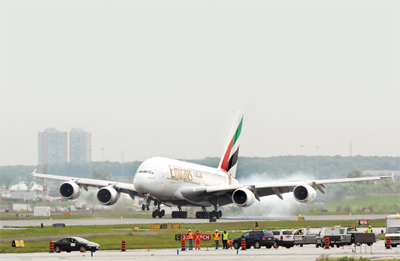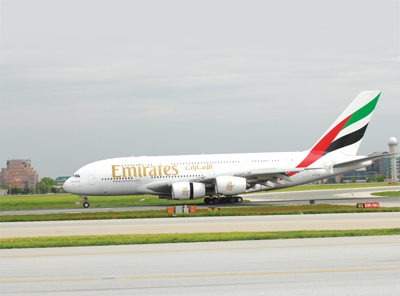
Features
Aircraft
Maximizing the A380
The current air transport agreement between Canada and the United Arab Emirates allows U.A.E. carriers access to one Canadian city six times per week. Emirates serves Toronto from Dubai every Monday, Wednesday and Friday, while Etihad Airways flies into Toronto from Abu Dhabi every Tuesday, Thursday and Saturday. No Canadian carrier currently operates its own aircraft to the U.A.E.
September 27, 2010 By Frederick K. Larkin
Recently there has been increased attention paid to the efforts being made by Emirates, the Dubai based airline, to gain greater access to Canada. The heated verbal volleys back and forth between the numerous parties directly involved (airlines, government agencies, consumer advocates, unions, politicians and consultants) have included terms such as dumping seat capacity, providing economic benefits, poaching traffic, increased employment, free trade must be fair trade, and protectionism.
 |
|
| Emirates currently has 11 A380s in service, with another 79 on order.
|
The current air transport agreement between Canada and the United Arab Emirates allows U.A.E. carriers access to one Canadian city six times per week. Emirates serves Toronto from Dubai every Monday, Wednesday and Friday, while Etihad Airways flies into Toronto from Abu Dhabi every Tuesday, Thursday and Saturday. No Canadian carrier currently operates its own aircraft to the U.A.E.
Emirates has expressed its interest in being able to eventually operate two flights in and out of Toronto daily, as well as to initiate service to Vancouver and Calgary. In order to optimize its limited exposure to Canada’s largest regional market, Emirates is utilizing the largest aircraft in its fleet – the Airbus A380.
The airplane
In order to better appreciate how the aircraft fits into its peer group of large-capacity long-range airliners, some specifications and performance data on the four most popular airplanes are provided in the accompanying table.
Emirates currently operates its A380s with two slightly different interior configurations – one with 489 seats (14F/76J/399Y) and one with 517 seats (14F/76J/427Y). The difference between the two is the substitution of 28 Y-class seats (seven rows of four centre aisles at the rear of the main deck) with a crew rest compartment. The 489-seat variant is therefore used on longer stage lengths where crew duty time limits come into play. With either configuration, the first class and business class cabins are on the upper deck, while the economy class cabin occupies the main deck.
As one might expect of a 21st century design, all three-passenger cabins are designed to make a long haul journey feel shorter than it is. The economy class cabin features 10-abreast seating (3-4-3) with a 32" seat pitch. Each seat has access to the aircraft’s in-flight entertainment system that provides more than 1,200 channels of movies, audio, games and television on a 10.6" digital screen. As well, each seat has power and a USB connection that permits the use of laptops/portable devices and the ability to send and receive telephone calls and e-mail.
The business class cabin has four-abreast seating (1-2-1). The seats have a pitch of 48" and can recline to become a 79" flat bed. Each seat features dual port USB, an extra-large table and a 17" digital screen. Should work not become a priority, every seat has a built-in mini bar.
If you learn that your Global or Gulfstream isn’t available, you might consider Emirates’ first-class cabin. It features 14 suites that boast an 86" seat pitch, a massage-giving chair that converts into a bed with a mattress from which you may watch the 23" screen. First class passengers also have access to the two shower equipped washrooms in the nose of the aircraft. A sign on the shower door reads “Maximum Two Occupants,” just in case someone is tempted to transfer the party from the cabin’s lounge/bar.
Overseeing the progress of each A380 flight is a crew that consists of four pilots and 30 flight attendants.
The mission
What strategic role does this mighty machine play for Emirates and where is it currently deployed? Given Emirates ambition of building Dubai into a global hub similar to London’s Heathrow, Tokyo’s Narita and Beijing’s Capital, the A380 plays a crucial part in bringing seat capacity and an attractive range of in-flight services to the airline’s network.
 |
|
| The A380 is ideal for slot-constricted airports or for markets where the carrier’s access is limited by a bilateral agreement.
|
The aircraft is ideal for slot-constricted airports or for markets where the carrier’s access is limited by a bilateral agreement. Although Emirates does not currently operate a high density version of the A380, it has given consideration to a 600-seat/two-class configuration for city-pairs that have suitable levels of traffic.
With a cost per available seat mile (CASM) that is estimated to be 20 per cent below that of the next largest passenger airliner (the Boeing 747-400), the A380 provides a much desired operating cost discipline.
The following table shows where Emirates is using the A380 to capture traffic for its network and to develop market presence.
Emirates operated the A380 between Dubai and New York’s JFK airport from August 1, 2008 until late May 2009, when it introduced twice daily service on the route with Boeing 777-300ERs. The A380 was then transferred onto the Dubai-Toronto route beginning on June 1, 2009. Emirates had been servicing Toronto with 354-seat 777-300ERs from October 29, 2007. The up-gauge in equipment resulted in a 38 per cent increase in seat capacity per flight.
Emirates currently has 11 A380s in service, with another 79 on order. Its total order of 90 aircraft represents 39 per cent of the 234 aircraft ordered to date and is more than four times the size of the second largest order – 20 from Qantas Airways. At approximately US$330 million per copy, it is a meaningful wager on future global economic growth.
The green monster
Boston’s Fenway Park has one and so does Airbus. The A380 burns only three litres of fuel for every 100 available passenger kilometres. This translates into the production of only 75 grams of carbon dioxide per passenger for every 100 kilometres flown. In addition to being cleaner than any other jet airliner, it is much quieter. Studies performed at Sydney, Australia and Frankfurt, Germany indicate that the A380 is more than three decibels quieter than a Boeing 747-400. That may not sound like much of a difference, but in fact means that it is 50 per cent quieter on approach and on departure. That makes the A380 compliant with the ICAO Chapter Four noise standards.
The change agent
Oil was discovered in Dubai in 1966. Six years earlier, its airport opened with a 5,900-foot-long runway of compressed sand. Much has changed during the past half century. Today real estate, financial services and tourism play bigger roles in the Emirate’s economy than that of the petroleum industry.
Dubai International is currently the 11th busiest airport in the world, based on passenger traffic statistics published by Airports Council International of Geneva, Switzerland. Four years ago it didn’t rank within the top 30 airports.
Like its hometown, Emirates has experienced dramatic growth during the past decade. The carrier continues to expand its network towards its goal of connecting the world through a hub in what was once considered a remote location. In that effort, the A380 is proving to be an effective catalyst in the company’s evolution.
 |
|